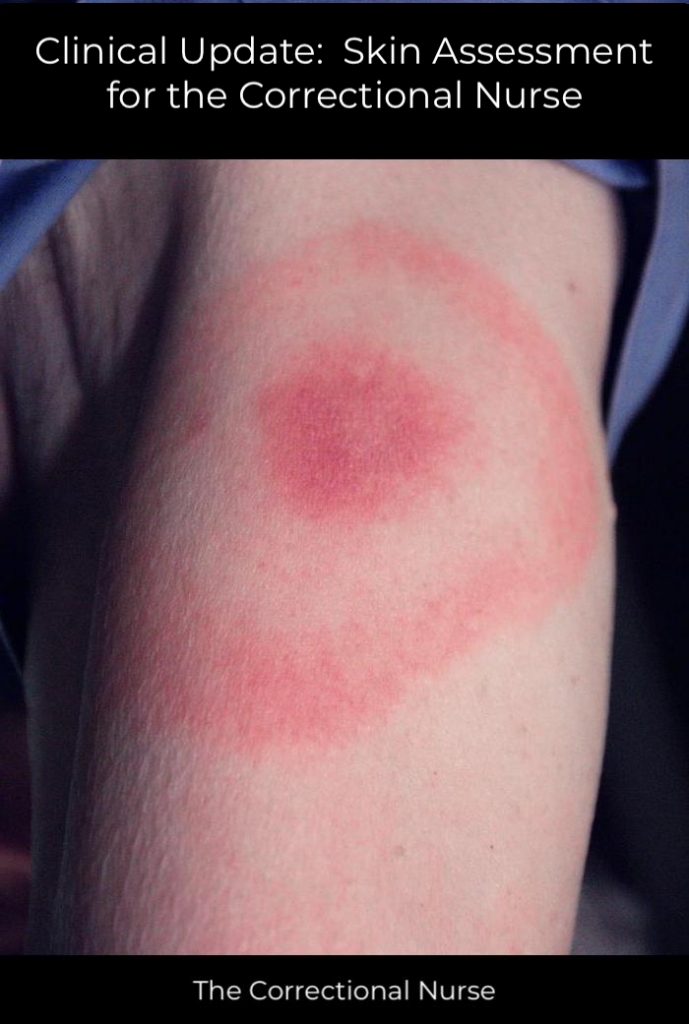Ask any nurse who triages the medical requests or any nurse who conducts nurse sick call, and they will tell you that skin rashes and lesions are frequently a problem for our patients in the correctional environment. This has been attributed to a number of unique characteristics of the correctional environment, like being in close quarters, and patients with histories that include substance use disorder and poor personal hygiene.

The Language of Skin
When conducting an evaluation of a patient with a skin complaint, it is important to use the correct description of the rash or lesion with which the patient presents. In this post, we will review nine common lesions that correctional nurses may observe. In our next post, we will discuss six secondary lesions that are commonly occurring and may be identified during the examination of a patient with a skin complaint.
This information is from Skin Assessment for the Correctional Nurse and Skin Assessment II for the Correctional Nurse from The Correctional Nurse Educator.
Be sure to visit Nursing Behind the Wall, where you will find a clinical case involving a skin complaint that will help you review the Subjective, Objective, Assessment and Plan for the patient presenting with a skin rash.
Common lesions
Note: Due to copyright laws I cannot post our pictures of each lesion here, but I have included a link to a summary page of pictures.
Macules are flat, nonpalpable lesions usually < 10 mm in diameter. Macules represent a change in color and are not raised or depressed compared to the skin surface.
Papules are elevated lesions usually < 10 mm in diameter that can be felt or palpated. Examples include nevi, warts, lichen planus, insect bites, seborrheic keratoses, actinic keratoses, some lesions of acne, and skin cancers. Papules are typically further described by shape, size, color, and surface change.
Plaques are palpable lesions > 10 mm in diameter that are elevated or depressed compared to the skin surface. Plaques may be flat topped or rounded. Lesions of psoriasis and granuloma annulare commonly form plaques.
Vesicles are small, clear, fluid-filled blisters < 10 mm in diameter. Vesicles are characteristic of herpes infections, acute allergic contact dermatitis, and some autoimmune blistering disorders (eg, dermatitis herpetiformis).
Bullae are clear fluid-filled blisters > 10 mm in diameter. These may be caused by burns, bites, irritant or allergic contact dermatitis, and drug reactions.
Urticaria (wheals or hives) is characterized by elevated lesions caused by localized edema. Wheals are pruritic and red. Wheals are a common manifestation of hypersensitivity to drugs, stings or bites. Autoimmune issues and physical stimuli, including temperature, pressure, and sunlight, may also cause urticaria. Typically the wheals last less than 24 hours.
Petechiae are non-blanchable pinpoint areas of hemorrhage. Causes include platelet abnormalities (e.g., thrombocytopenia, platelet dysfunction), vasculitis, and infections (eg, meningococcemia, Rocky Mountain Spotted Fever, other rickettsioses).
Purpura is a larger area of hemorrhage that may be palpable. Palpable purpura is considered the hallmark of leukocytoclastic vasculitis. Purpura may indicate a coagulopathy. Large areas of purpura may be called ecchymosis or bruise.
Telangiectases are areas of small, permanently dilated blood vessels that may occur in areas of sun damage, rosacea, systemic diseases (especially systemic sclerosis), or inherited diseases (eg, ataxia-telangiectasia, hereditary hemorrhagic telangiectasia) or after long-term therapy with topical fluorinated corticosteroids.
Using the common language of skin lesions when you communicate with your colleagues and providers about the condition of your patient will allow clear understanding of findings and will aid in a proper diagnosis and treatment for your patient.
Leave a Reply